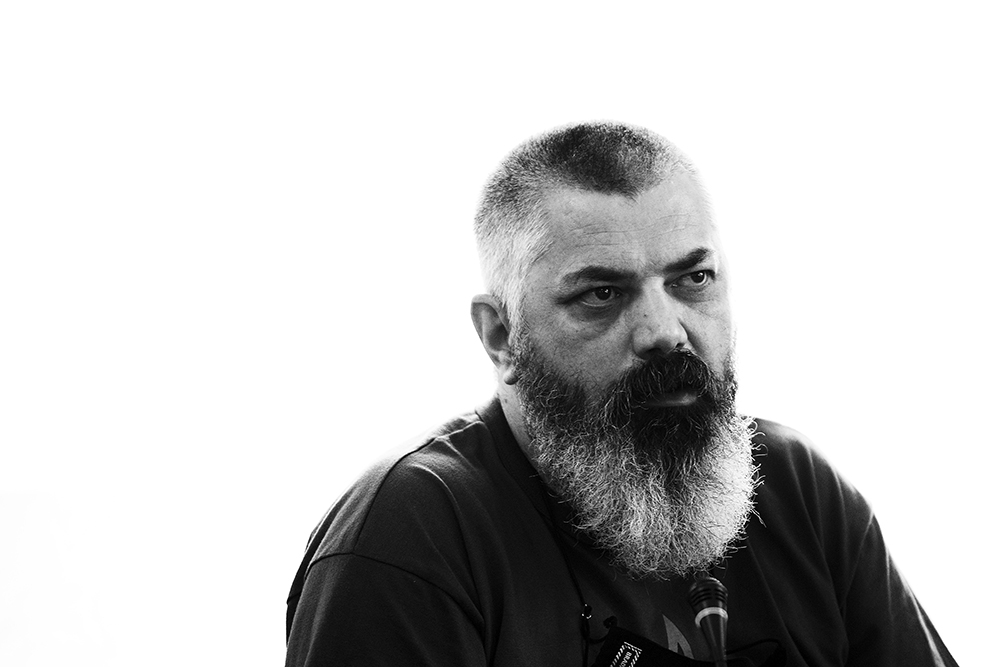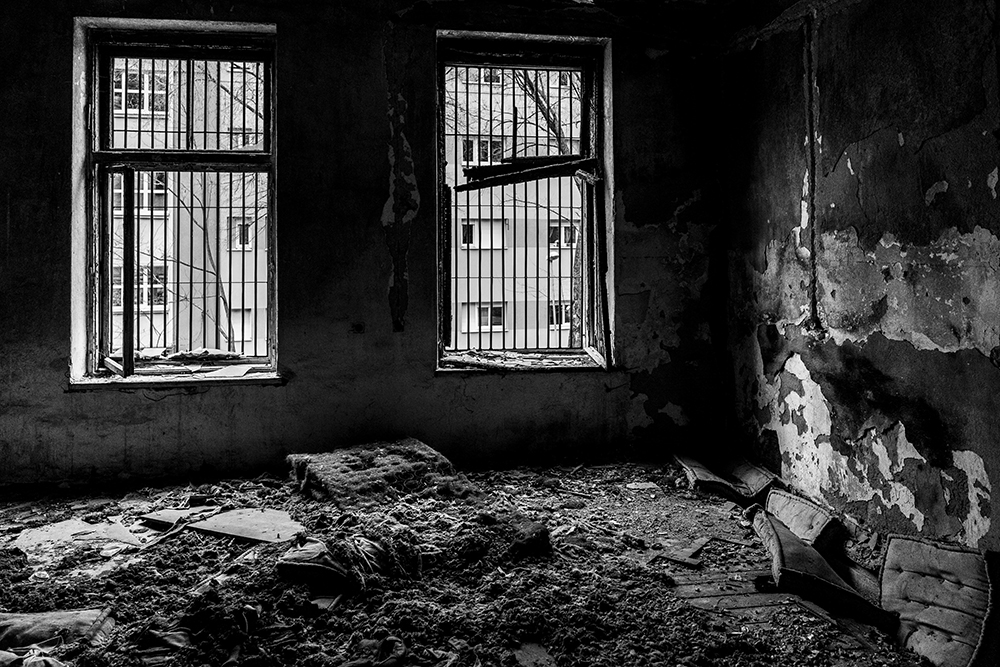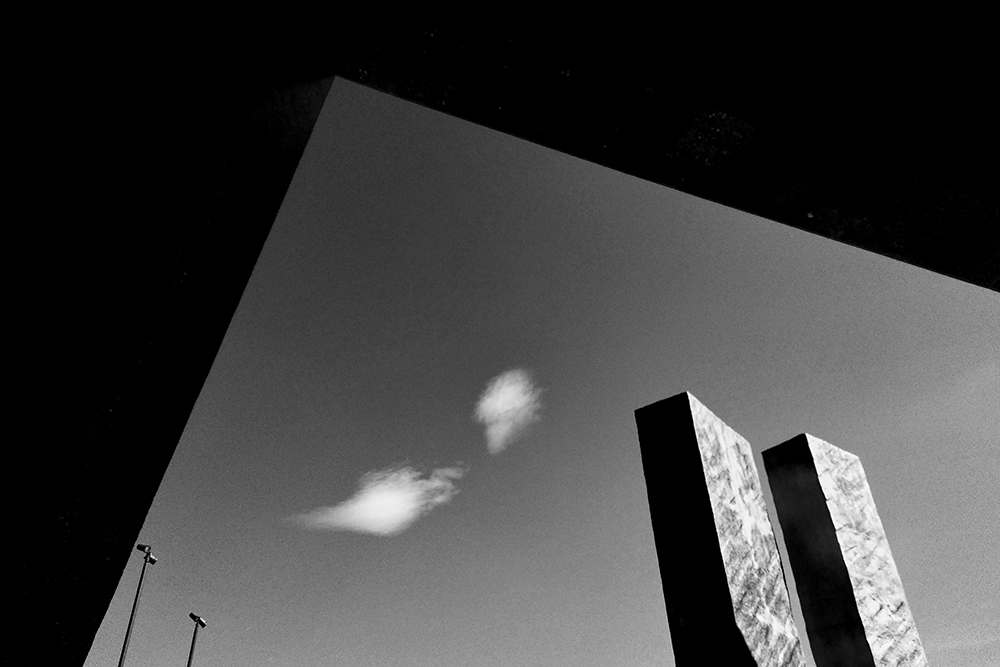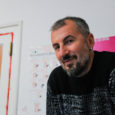In early July this year, anthropologist and photographer Igor Čoko — born in Knin, Croatia, residing now in Serbia’s capital — organized a photography exhibition in Belgrade of Midhat Poturović’s photos from Srebrenica. At the exhibition Poturović received an award named for Hrvoje Polan, who was one of the region’s best working photographers before he passed away in 2019. The award was established by the digital magazine grain.rs, launched by Čoko a few years ago.
The photos of Srebrenica after genocide, which Serbia still doesn’t recognize as such, arrived in Belgrade in this manner. As with other attempts at commemoration, genocide denial attracted ultranationalists to the exhibitition where they relentlessly, and with impunity, exposed the ugliest side of this city. They did the same thing on July 10, the day before the commemoration of the 26th anniversary of the genocide, when the human remains of an additional 19 victims were buried in Potočare, Srebrenica. On the previous day, a group of nationalists sought to disrupt a gathering of the activist group Women in Black on Belgrade’s Republic Square. The activists had rallied there to commemorate the victims of Srebrenica and call out Serbia’s responsibility.
Igor Čoko is someone who won’t allow Srebrenica, as well as numerous other such places and events, to be forgotten. In the same way he doesn’t allow society to ignore the existence of people forced to live on the margins. For years, he has been following and taking photos of refugees, prisoners and people who live in the streets.
Alongside that, he is one of the founders of the association Grain. For six years now they have been publishing a magazine of the same name with the goal of developing a culture of engaged documentary photography.
After headlining K2.0’s media carnival, Igor Čoko spoke with us about his photos, about the importance of photography in the process of dealing with the past, and also in dealing with everything that is going on around us, the things we don’t want to see, but must.

Igor Čoko, a photographer who protects the world from the oblivion of forgetting. Photo courtesy of Goran Boričić.
Dejan Kožul: Recently, a photography prize was established and awarded for the first time; it is named after Hrvoje Polan, a photographer who died in 2019. The award was given to Midhat Poturović for his work on Srebrenica. What binds these two photographers together?
Igor Čoko: The Hrvoje Polan Award was established by the Grain association and is named for one of the bravest and most daring photojournalists from the region, a man who didn’t mind putting his hand in the fire to get the truest information — this later became the mark of his photographic handwriting and his attitude toward life, from the time he worked in the Split-based daily “Feral Tribune,” up to his engagement with Agence France-Presse in the Near East and the Middle East.
How Partisan commander Koča Popović was — a lucid, ingenious soldier and a cheeky humanist — that’s also how Hrvoje was in a photographic sense. Literally. Hrvoje’s classic photo reportage is the one that the Split newspaper Feral Tribune published after the fall of Krajina. When all the other photojournalists were photographing Croatian President Franjo Tuđman and his crew at the Knin Fortress, Hrvoje was taking photos of the looting of store shelves in Knin’s shopping mall, thus evoking the dark side of the victorious Croatian military action.
Midhat in his own work skillfully and very intelligently engages with Srebrenica, not only with the day of July 11 but with all 365 days of the year. He has the need to clearly define the scope of the crime that took place there. He doesn’t photograph tears, rather he tries to bring about tears in the eyes of the viewer through deep emotional contrasts, a task he has absolutely succeeded at. Simply put, I couldn’t have thought of a better laureate to receive this prize.
The opening of the exhibition itself was not thrown off course by the protests of a handful of neofascists, but what was disrupted, I’d say, was the reporting of the media because more attention was paid to them than to the exhibition itself and its importance. To what degree is the media an accomplice in redirecting the topic?
It’s crushing how the media, including the “independent” ones who attended the opening of the exhibition and heard deep, meaningful, and profane speeches of the organizers and the laureate, left the gallery so they could film a handful of demonstrators protesting against the exhibition, just because they heard them yelling into a megaphone.

Igor Čoko and Midhat Poturović at the opening of the Belgrade exhibition dedicated to Srebrenica. Photo: Dejan Kožul.
Hey! The exhibition is taking place in Belgrade, the place from which so many bad things were set in motion during the time of Slobodan Milošević, things that brought about Srebrenica, the Kosovo war, the military operation Storm… By allowing such exhibitions and gestures, this city is finding the courage to remain a great city and express deep piety toward the victims, to undergo a personal catharsis, which is in and of itself bold and subversive. And then you all run out to get a bit of sensationalism and a semi-exclusive media story, you’re looking for some big hub-bub because a handful of guys showed up, guys who when all these events took place weren’t even born, weren’t even in the five-year plan, and you give them attention. You literally offer them on a plate the chance to steal the show just because of a few chants about the war criminals who de facto and de jure caused the tragedy in Srebrenica.
The media reports didn’t start with “Prize awarded for the Srebrenica photos…” but “Right-wingers gathered, there will be trouble…” Deplorable and tragic. Devastating. Disgusting.
The most important thing to me is that this exhibition has found its way to the people, that it was held in Belgrade, that the award named for a Croatian photographer was given in Belgrade to a Bosnian. Although we don’t see Hrvoje as a Croat, or Midhat as a Bosnian, but rather as exceptional photographers who boldly touch on scorching topics in a humanistic manner. All else is irrelevant because we have risen above physical borders, confines, and ethnic fences.
All sides have their evidence of such acts, they have their demons, but everyone must clean up their own yards.
And I don’t want to talk about the protesters. They exist, existed, and will continue to exist, they will keep on yelling against every stimulus of this sort. But I don’t want to promote them, mention them, give any attention to them. Because in this they steal the energy from the core of what we are dealing with. By this I mean the conversations on topics from the recent past about which we must discuss intensively and try to get the younger generation, which has grown up with the poor historical upbringing of their parents, to approach the real situation and build a dignified culture of remembrance in these areas.
In this sense, what’s the power of photos in the struggle against denial, for preserving memory and incentivizing empathy?
Photography is a crucial thing. The essential document and witness of a time. Proof that something happened, and that it wasn’t the result of some fabrication of anti-Serbian conspiracy theories and Soros’s NGO mercenaries whose only goal is to obliterate myth and the nation.
All sides have their evidence of such acts, they have their demons, but everyone must clean up their own yards. Undergo their own catharsis, their own purgatory. I hate it when people barge in with the counter thesis “and what about what they did to us…”
We were all stabbing each other in the previous wars. But let’s be realistic and boldly confront the fact that our guys somehow got lost a bit, gave themselves a bit more room to be more clever and creative in committing crimes, and in return for these perversions they ended up sacrificing their own people in Croatia and Kosovo. Because Operation Storm and the expulsion of Serbs from Kosovo are the unfortunate epilogues of the games that the Serbs engaged in and then severely overplayed.

Photos from the series “Karaburma, my ghetto.” Photo: Igor Čoko.
The Serbs in Croatia weren’t defeated by the Croatian army, nor were the Serbs in Kosovo defeated by NATO and the KLA, but by the political strategy of Slobodan Milošević and the factions of people who are today part of the executive branch in Serbia, disguised in the silky colors of Euro-Atlantic integration and silky prosperity, with never a care for the history which doesn’t suit them. Just like we didn’t beat fascism in 1945. We did win the battle, but the war is still ongoing at different levels and in a vastly more perfidious manner.
Photography is there to leave a mark. It’s honest, direct, and engaged. Like Hrvoje’s. Like Midhat’s.
Srebrenica is one of the anniversaries, and there’s also the fall of Vukovar and Operation Storm… All these are topics that the digital magazine Grain.rs addresses. As far as I know, there are some plans to publish something on those anniversaries as well or perhaps to put on an exhibition?
Grain has had many exhibitions on the topic of the war in Kosovo, ones which weren’t typical or with a pro-Serbian narrative. On the contrary.
During the exhibition of the late Dutch photographer Willem Poelstra, who in his book perhaps best described the post-war reality in Kosovo, the photos are full of monuments to Adem Jashari and the killed KLA fighters. But this shouldn’t be seen or interpreted as a provocation. These are artifacts of that time and the contemporary historical legacy of that region. Evidence of something that occurred there. And exists as a trace of it. Now, whether somebody likes it or not, that’s a different story.
We can all arrive at a situation where we are all on the margins. Eternal hedonism is guaranteed to no one.
But when we discuss these things, the truth must be transparent, in the same way, Poelstra’s photos feature Serbs who still live in Kosovo. The truth must be unique, without censorship. And that’s Grain’s mission, developing a culture of remembrance.
We have so much of this stuff to talk about that we wouldn’t ever get bored because these things… there needs to exist another, a different, perspective from the official state version. Unrestrained.
In your work, you are dealing with people — from those on the move, such as refugees, to prisoners, people living in the streets… What do they all have in common, what is it that draws you toward them?
I’m an anthropologist and documentary filmmaker by education. I left my former profession of journalism in order to become involved, through photography and a visual anthropological approach, with engaged and difficult themes, human tragedies and traumas.

For years, Igor Čoko’s camera has been focusing on the lives of refugees in Belgrade’s streets. Photo: Igor Čoko.
The easiest thing is to take photos of the sunset, of Ferdinand smelling flowers, snuggling into your own comfort zone and not worrying about other people’s problems. All around us is life with all its pitfalls and perils. I’m here to document this reality.
From people on the margins, refugees, prisoners, fallen angels, I’ve heard some of the most powerful life truths, advice, and experiences. These are situations when you become stronger as a human being, you brashly impose empathy on people — I mean the viewers — and if they accept it, then they can see the other side of life as well.
About the heroes of my photos and that world under the radar, I don’t really want to talk about that. In the end, we can all arrive at a situation where we are on the margins. Eternal hedonism is guaranteed to no one. My projects, which I pack into photography books, will stay as a reminder and breathe fully the way they should, perhaps in 20 years, when the power goes out, fuck it, the memory in the mass of information will continue to live on as the flight of a butterfly.
Lately you are often in the role of an instructor. What is it about photography that young people are interested in and are they drawn to the anthropological approach you use?
For years now I have been sharing my photographic experience with students throughout Europe, Serbia, but also the rest of the world, now through the Zoom platform. There I can see the meaningfulness of my work and engagement in the field of documentary photography. That way I can present people with many things they are unable to see from their comfort zone or some stuff that they don’t even notice. That way I can entertain them and literally accompany them through the level of rock bottom, after which they won’t be so indifferent but they will feel a sense of gratitude for their lived experience and understand the meaning of empathy.

From the series “Invisible children of Belgrade.” Photo: Igor Čoko.
To me, those lectures and young people are a kind of vacation and inspiration. They inspire hope for a better world. At least a bit better.
What’s your view of the media’s attitude toward photography today and to which extent did photography lose the trust that people had toward it, as is the case with journalism?
Today, everybody is taking photos, but few are photographers. Today, everybody writes, but only a few are journalists. And even fewer are journalists guided by ethical tenets. People like us are at the bottom, hardline underground. Guerilla. Partisans. But leave us be, we are here.
The media has long since lost its way. The same goes for photography in the media. Because, if it isn’t a selfie, if there aren’t asses and boobs, if it isn’t some political snooping, some paparazzo, or dead children to shock the beholder, then it’s no good.
Photography in the media today is just all surface, or for shock — no ethics and all nonsense. No fundamental truths. That wouldn’t sell the story. I feel sorry for all the people who get caught up in all this.
I follow what’s happening in the media, but what I like watching the most is the kid’s channel Baby TV. I love how good they have it there,
Serbia has never been this deep in a media gutter as it is today. The jaundice is at its terminal stage. The “free” media have either become terribly sterile or are flirting with sensationalism, merging with the disease but being allegedly somewhat different. A difficult and foul place to be in. So what does one do? You go into the forest and fight the battle against the occupier.
Feature photo: Igor Čoko.






